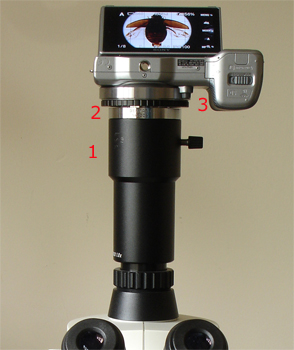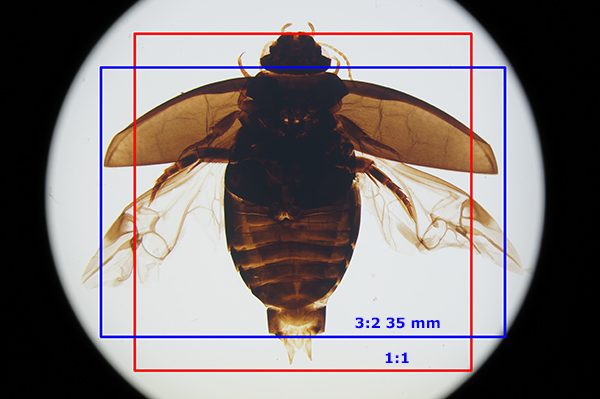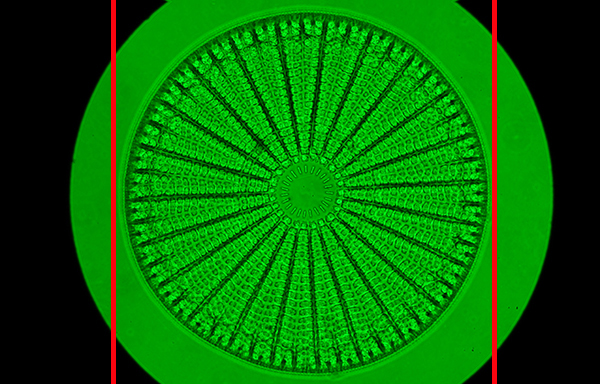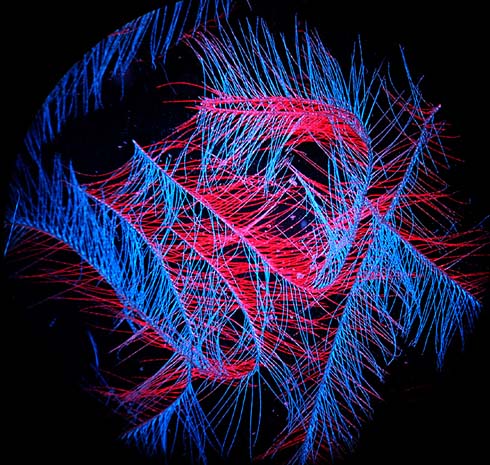Vignetting in photomicrography will be very familiar to microscopy enthusiasts when exploring and optimising homebrew camera/relay lens/adaptor setups. There are two main types.
The first occurs when only part of the circular visual field is presented at the film / sensor plane giving either a complete / partial black circular border or at the corners. This type is likely the least acceptable especially if it limits the amount of subject captured.
The second is when the full visual field is captured but again gives either a complete or partial black circular border. This type when experienced on small format film is likely not acceptable but in these days of predominantly digital cameras it is not necessarily irksome and potentially has some benefits both with image capture and ancillary equipment costs. These aspects are explored below based on my own experiences.
Previous experiences setting up a Leica S series stereo (May 2016 Micscape article)
Since the advent of affordable digital camera technology the more modern microscope systems both stereo and compound have been designed primarily around small image sensors for the photo port. This was the case with my Leica S series stereo. Using the first stage reasonably priced photo adapter a typical '1 inch' sensor microscope camera was intended to give vignette free parfocal images (image right below). My camera at the time was a Canon 600D APS sensor DSLR and on hindsight made the
mistake of investing in the second stage Leica adapter for full frame use (image left below). It was expensive, produced an impractical, long, vibration-prone extension on the scope and was unsuited for APS where the area capture cf visual was small.
The better and more cost effective solution was to adopt a used Sony NEX 5N with C-mount adaptor directly on the first stage adaptor. It also has an electronic first curtain shutter option for essentially vibrationless operation. This does not have the feature of remote operation from the PC but more recent makers' mirrorless models might.



Leica stereo, left and middle image. It can be more practical and cost effective to buy a used camera to fit an adaptor (Sony NEX 5N with C-mount adaptor, middle) rather than commit to additional adaptors for a less suited camera (Canon 600D, left). Although both have an APS sensor, the NEX 5N is mirrorless and presents the image at the same plane as a C-mount microscope camera so
parfocal. The DSLR with its longer distance to the sensor is a long way off parfocal and poor coverage of the visual field (even if sensor was full frame).
Nikon Eclipse E800, right, photo port on Ergo trino' head.
Setting up a Nikon Eclipse E800
 When setting up an E800, as with the Leica stereo, it has the common 38 mm ID port designed for a lensless 1X camera adapter for a small sensor microscope camera. The Sony NEX with C-mount adaptor sits well here capturing the full field and almost parfocal at higher mags. The 10X screen zoom allows critical focusing. Example images shown below.
The Eclipse system diagram does show relay lens adaptors to fit larger sensor cameras but would be expensive and as shown below for the stereo, little is to be gained and ability to capture the full field lost.
When setting up an E800, as with the Leica stereo, it has the common 38 mm ID port designed for a lensless 1X camera adapter for a small sensor microscope camera. The Sony NEX with C-mount adaptor sits well here capturing the full field and almost parfocal at higher mags. The 10X screen zoom allows critical focusing. Example images shown below.
The Eclipse system diagram does show relay lens adaptors to fit larger sensor cameras but would be expensive and as shown below for the stereo, little is to be gained and ability to capture the full field lost.
The Leica stereo adapter 2 above does fit on the photo port providing a vignette free image on full frame/APS cameras and well corrected images with the APS sensor but some loss of planarity towards the edges for a full frame (a Canon 5D Mk. II was briefly owned to assess) but neither of benefit to capture full fields.
The merits of capturing the full field
Square or rectangular format film/sensors can never be an ideal fit into a projected circular image field. Consumer digital cameras sold in the last few years have a large image pixel count and well beyond that required to capture microscope images and capturing all the resolved detail. After cropping within the vignette the Sony still gives an 8 Mpixel image from the 17 Mpixel sensor, more if crop outside the vignette as for the diatom below.


